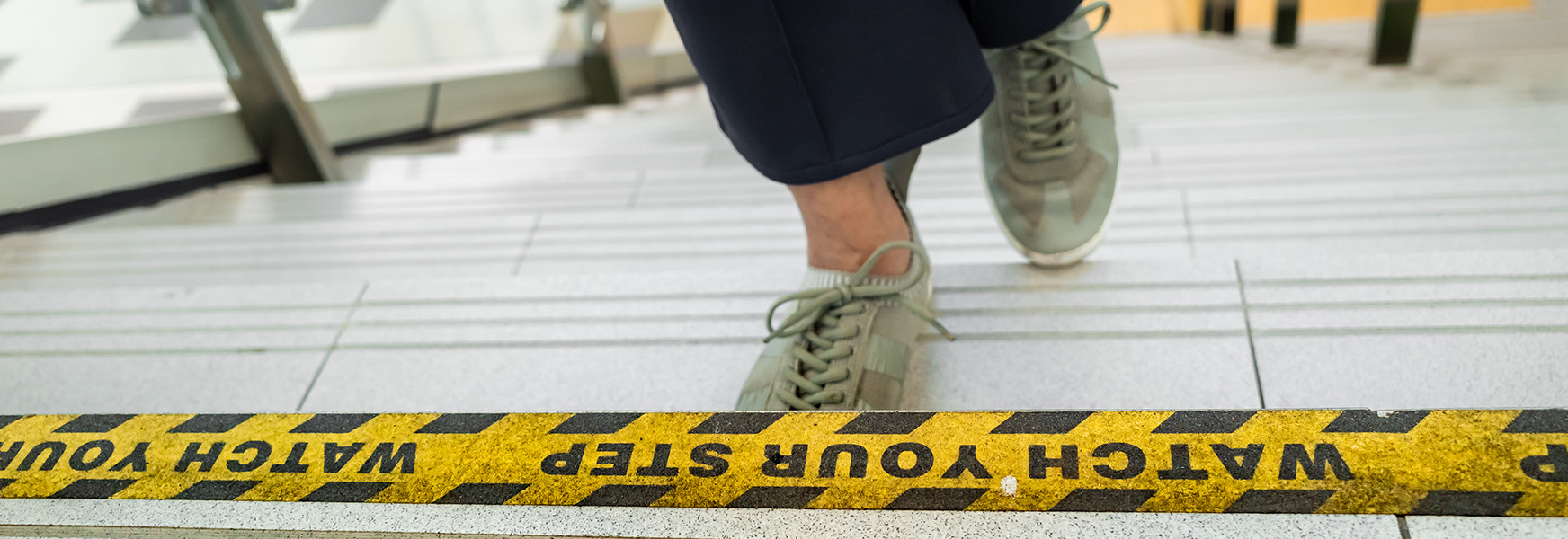Addressing Slips-and-Falls from the Ground Up

Usually, if you want to “build a better mousetrap,” you need to start from scratch because even though the current version has been tweaked and changed a million times, the mice still win occasionally. Like with mousetraps, solutions for slip-and-fall events have been rehashed, rebranded, and reimplemented for every industry, environment, and population. Yet these events still happen.
Let’s look at slip-and-fall events from the ground up. What causes them, what contributes to them, and what helps us mere humans to stay upright when others come crashing to the ground?
Start with the ground. The ground -- or the surfaces we ambulate on -- come in a vast array of configurations and conditions which contribute to a baseline level of traction or friction coefficient that should help us stay on our feet. However, even a surface that normally has a lot of grip, like carpet, can have hidden changes such as wear, or contaminants such as oil or water saturation, that cause a decrease in the expected friction.
Usually, the person on that surface doesn’t have control over it. Surface design, installation, and maintenance are up to the building or business owner. Surface solutions work best when they are facility-based and include assessments, repair, maintenance, replacement plans, regular inspections, and conditions response.
The next level up is what is on your feet; more specifically, the tread on the bottom of shoes and boots. There are as many types of footwear as there are combinations of surfaces, and their compatibility with the surface can, in itself, be a determining factor in a slip-and-fall event.
An outdoor boot with a hard, deep tread can have reduced friction on a hard polished surface like quarry tile or marble. Or a hard, smooth leather sole on anything wet or oily can be a disaster. A fast gait or a long stride further reduce friction by limiting the heel’s contact point on the surface.
While we can’t be expected to change our footwear for every surface we encounter, in the workplace, there can be an expectation for footwear to match the work environment.
Let’s move up from the feet and look at the rest of the body and how it contributes to our balance.
Balance is all about keeping the center of gravity (CoG) over the base of support (BoS) or your belt buckle between your feet. A person’s overall fitness, agility, and the condition and flexibility of ankles, knees, hips, and back contribute to the ability to maintain balance. As a matter of fact, the condition of a person at the time of a slip-and-fall event is the most important factor in a positive outcome. While it would be great for everyone to be at peak physical and mental condition, it’s more realistic to expect an understanding of our limits -- and act accordingly.
Next up is the head, which plays a particularly important role in avoiding slip-and-fall events as we take in and process sensory information around us. The more details we get from our observations, the more informed our decisions can be. Should we engage or avoid? Go fast or go slow?
Many things can affect the quality and frequency of our observations. Personal distractions such as mobile devices, conversations, and stress can divert attention from our path. Familiarity can dull our awareness. Perhaps we’ve successfully navigated a hazard in the past and don’t regard it as important, or don’t think to look for a new hazard.
Methods to improve observation fit into two categories. First, internal, involves behavior-based changes such as paying attention and avoiding distractions. This is best achieved through consistent messaging, training, and feedback. Second, external, calls attention to hazards, such as lighting, high-visibility paint, barriers, dedicated paths, or signage that changes to highlight weather or unpredictable hazards.
The last piece to consider is the environment in which we are moving. Light or lack thereof, crowding, noise level and variations, traffic, weather, equipment interactions with pedestrians, or any combination of these things, can contribute to the conditions that cause a slip-and-fall event.
Again, an ambulator has little control over environmental conditions, but they can change the choices they make … if they are paying attention.
So, let’s put it all together. As a business or property owner:
- Be aware of the Surfaces in and around your facility. Know the composition, manage the condition, and control contamination of the surfaces for those expected to use them.
- Help your team increase their Awareness of hazards including surface composition, changing conditions, and our mental and physical limitations, through signs, safety briefings, orientations, health screenings, and auditory and visual aids. Be creative and make the message meaningful.
- Create a Footwear policy and provide guidance and assistance to your team to purchase the proper footwear for the working conditions.
- Assess the Environment your team will be working in and how it might distract from making accurate and frequent observations of surface hazards. Consider what changes can be made in the environment or what tools your team has to deal with those challenges.
So, in the end, to build a better slip and fall prevention program, think SAFE – Surface, Awareness, Footwear, and Environment.
Check out the Slip and Fall prevention resources MEMIC has on the Safety Director at www.memicsafety.com, where you can find a sample slip-and-fall prevention policy, a surface evaluation checklist, and Slip and Fall Awareness posters.

